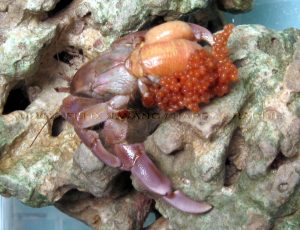written by Vanessa Pike- Russell 2000, updated by Stacy Griffith

The life cycle of the land hermit crab is unique. It starts by the release of eggs into an ocean tide pool, where the zoea go through a series of moults and developmental stages.

A baby hermit crab zoea will be a part of plankton until it grows and starts to resemble hermit crab form. Once they have developed to maturity, hermit crabs leave their watery home, making the long journey to land to find a shell for the protection of the soft abdomen.


Once ashore, land hermit crabs go through a metamorphosis, developing modified gills that act as lungs to enable them to breathe air. Once on land, they live in a variety of environments including trees, mangroves and areas up to 1-2 miles away from the shore.
In the wild some land hermit crabs can spend a long time away from a water source, some only returning to the sea when they are heavy with eggs which they will flick into the intertidal pools to start the cycle over again. Land hermit crabs are instinctive and will access moisture from dewdrops found on leaves of plants. They are able to go without food for a time if necessary and store water in their shells for drinking later.

Hermit crabs are able to regenerate – or regrow – any lost or broken limbs during the moulting process. Hermit Crabs moult because their hard exoskeleton does not grow with their body, and so they must shed it and infuse the new tissues with moisture, then harden these tissues to develop into an exoskeleton with the aid of ‘chitin‘.
During this time, you will need to keep your hermit crab in a comfortably warm and moist environment and offer substrate into which they may burrow within. Some hermit crabs like to dig down deep into the substrate and hide out while their new exoskeleton hardens and they will return to normal activity. For the next 10 or so days heir new skin hardens with the aid of ‘chitin‘ which hermit crabs will obtain by eating their discarded exoskeleton. During this time of natural wonder, you will find your hermit crab is soft, vulnerable, and inactive.
After moulting, your crab will need a bigger shell to protect their newly moulted body. Your hermit crab may be a little crabby after a moult and you should offer a variety of shells for them to choose from. Hermit crabs love to size up new shells and will often change shells for hours on end until they find their favourite.
References
- http://crabstreetjournal.org/wp-content/uploads/2024/12/1938-Spawning-and-Development-Coenobita-rugosus-Yamaguchi-Bulletin-of-Science-of-Kyushu-University.pdf
- http://crabstreetjournal.org/wp-content/uploads/2024/12/2015-Larval-growth-development-and-duration-in-terrestrial-hermit-crabs.pdf
- http://crabstreetjournal.org/wp-content/uploads/2024/12/2015-Larval-growth-development-duration-hc-scaevola-Hamasaki.pdf
- http://crabstreetjournal.org/wp-content/uploads/2024/12/2015-Larval-development-of-the-land-hermit-crab-Coenobita-violascens-Heller-1862-Decapoda-Anomura-Coenobitidae-described-from-laboratory-reared-material.pdf
- http://crabstreetjournal.org/wp-content/uploads/2024/12/2001-LARVAL-DEVELOPMENT-OF-THE-LAND-HERMIT-CRAB-COENOBITA-COMPRESSUS-H.MILNE-EDWARDS-REARED-IN-THE-LABORATORY.pdf
- http://crabstreetjournal.org/wp-content/uploads/2024/12/1992-Abbreviated-Larval-Development-in-the-Australian-Terrestrial-Hermit-Crab-Coenobita-variabilis-McCulloch-Anomura-Coenobitidae.pdf
- http://crabstreetjournal.org/wp-content/uploads/2024/12/1962-Larval-Development-clypeatus-in-laboratory-Provenzano.pdf
- http://crabstreetjournal.org/wp-content/uploads/2024/12/1938-Spawning-and-Development-Coenobita-rugosus-Yamaguchi-Bulletin-of-Science-of-Kyushu-University.pdf
Crab zoea devouring copepod:
Fantastic video of her hermit crab zoea
https://youtu.be/CRKeCI10aqE
From mating to hatching, hermit crab zoea:

